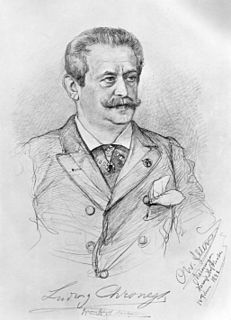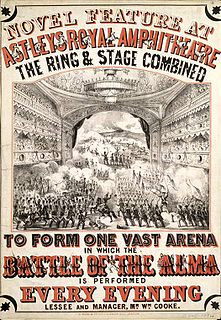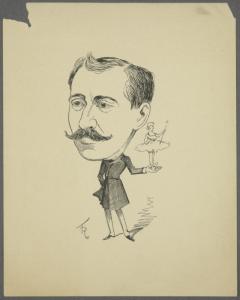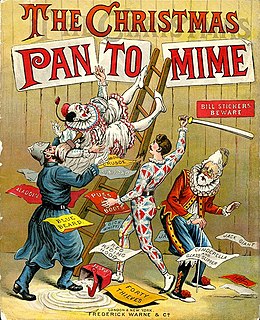 W
WNineteenth-century theatre describes a wide range of movements in the theatrical culture of Europe and the United States in the 19th century. In the West, they include Romanticism, melodrama, the well-made plays of Scribe and Sardou, the farces of Feydeau, the problem plays of Naturalism and Realism, Wagner's operatic Gesamtkunstwerk, Gilbert and Sullivan's plays and operas, Wilde's drawing-room comedies, Symbolism, and proto-Expressionism in the late works of August Strindberg and Henrik Ibsen.
 W
WAlexandre Germain was the stage name of the French actor Germain Alexandre Poinet. He created leading comic roles in several of Georges Feydeau's most successful farces.
 W
WThis article offers a list of productions directed by André Antoine. It includes only theatre productions that André Antoine directed. Antoine was a French actor, theatre manager, film director, author, and critic who is considered the father of modern mise en scène in France.
 W
WOtto Brahm was a German drama and literary critic, theatre manager and director. His productions were noted for being accurate and realistic. He was involved in the foundation of the progressive Die Freie Bühne company, of which he became president and producer. He also edited the company's weekly magazine of the same name, but later changed its name to Die neue Rundschau.
 W
WJohn Baldwin Buckstone was an English actor, playwright and comedian who wrote 150 plays, the first of which was produced in 1826.
 W
WThe Cercle Funambulesque (1888-1898)—roughly translatable as "Friends of the Funambules"—was a Parisian theatrical society that produced pantomimes inspired by the Commedia dell'Arte, particularly by the exploits of its French Pierrot. It included among its approximately one hundred and fifty subscriber-members such notables in the arts as the novelist J.-K. Huysmans, the composer Jules Massenet, the illustrator Jules Chéret, and the actor Coquelin cadet. Among its successes was L'Enfant prodigue (1890), which was filmed twice, first in 1907, then in 1916, making history as the first European feature-length movie and the first complete stage-play on film.
 W
WLudwig Chronegk was a German actor and director. He headed the Meiningen Ensemble and reformed theatre direction principles.
 W
WThe equestrian theatre company of Pépin and Breschard, American Victor Pépin and Frenchman Jean Baptiste Casmiere Breschard, arrived in the United States of America from Madrid, Spain, in November 1807. They toured that new country until 1815. From their arrival until the present day, what is now known as the traditional circus has had a presence in North America.
 W
WJohn W. Considine was an American impresario, a pioneer of vaudeville.
 W
WBenoît-Constant Coquelin, known as Coquelin aîné, was a French actor, "one of the greatest theatrical figures of the age."
 W
WGeorg II, Duke of Saxe-Meiningen, was the penultimate Duke of Saxe-Meiningen, reigning from 1866 to 1914. For his support for his successful court theatre he was also known as the Theaterherzog.
 W
WA Gesamtkunstwerk is a work of art that makes use of all or many art forms or strives to do so. The term is a German loanword accepted in English as a term in aesthetics.
 W
WWilliam John Hammond was a British actor-manager and singer of comic songs of the early 19th-century. He played Sam Weller in Samuel Weller, or, The Pickwickians in 1837.
 W
WWilliam Haviland was a British actor-manager specialising in the works of Shakespeare who during his long stage career performed with some of the leading actors of his time including Henry Irving and Herbert Beerbohm Tree.
 W
WHippodrama, horse drama, or equestrian drama is a genre of theatrical show blending circus horsemanship display with popular melodrama theatre.
 W
WSir Henry Irving, born John Henry Brodribb, sometimes known as J. H. Irving, was an English stage actor in the Victorian era, known as an actor-manager because he took complete responsibility for season after season at the West End’s Lyceum Theatre, establishing himself and his company as representative of English classical theatre. In 1895 he became the first actor to be awarded a knighthood, indicating full acceptance into the higher circles of British society.
 W
WBolossy Kiralfy (1848–1932), one of The Kiralfy Brothers, was a performer, producer, writer and creator of musical extravaganzas in the late 19th, early 20th centuries. He was a "great international showman" and ushered in the "era of the Spectacle". Bolossy Kiralfy, born January 31, 1847 in Pest, Hungary and died March 6, 1932 in London, England. Elise Marie Waldau, was his first wife which he married approximately 1874 and divorced 1899. His second wife, Helen (Nellie) Dawnay was married in November 23, 1899 in London, England.
 W
WThe Théâtre Libre was a theatre company that operated from 1887 to 1896 in Paris, France.
 W
WA modern melodrama is a dramatic work wherein the plot, typically sensationalized and for a strong emotional appeal, takes precedence over detailed characterization. Melodramas typically concentrate on dialogue that is often bombastic or excessively sentimental, rather than action. Characters are often drawn and may appear stereotyped. Melodramas are typically set in the private sphere of the home, focusing on morality and family issues, love, and marriage, often with challenges from an outside source, such as a "temptress", a scoundrel, or an aristocratic villain. A melodrama on stage, filmed, or on television is usually accompanied by dramatic and suggestive music that offers cues to the audience of the drama being presented.
 W
WMindre teatern, Nya teatern, Lindeberska teatern, was a Swedish theatre at Kungsgatan in Stockholm, active 1842–1863. The building was used as localities for the Royal Dramatic Theatre in 1863–1908.
 W
WThe Moscow Art Theatre is a theatre company in Moscow. It was founded in 1898 by the seminal Russian theatre practitioner Konstantin Stanislavski, together with the playwright and director Vladimir Nemirovich-Danchenko. It was conceived as a venue for naturalistic theatre, in contrast to the melodramas that were Russia's dominant form of theatre at the time. The theatre, the first to regularly put on shows implementing Stanislavski's system, proved hugely influential in the acting world and in the development of modern American theatre and drama.
 W
WNaturalism is a movement in European drama and theatre that developed in the late 19th and early 20th centuries. It refers to theatre that attempts to create an illusion of reality through a range of dramatic and theatrical strategies. Interest in naturalism especially flourished with the French playwrights of the time, but the most successful example is Strindberg's play Miss Julie, which was written with the intention to abide by both his own particular version of naturalism, and also the version described by the French novelist and literary theoretician, Émile Zola.
 W
WVladimir Ivanovich Nemirovich-Danchenko, was a Soviet and Russian theatre director, writer, pedagogue, playwright, producer and theatre administrator, who founded the Moscow Art Theatre with his colleague, Konstantin Stanislavski, in 1898.
 W
WPantomime is a type of musical comedy stage production designed for family entertainment. It was developed in England and is performed throughout the United Kingdom, Ireland and in other English-speaking countries, especially during the Christmas and New Year season. Modern pantomime includes songs, gags, slapstick comedy and dancing. It employs gender-crossing actors and combines topical humour with a story more or less based on a well-known fairy tale, fable or folk tale. Pantomime is a participatory form of theatre, in which the audience is encouraged and expected to sing along with certain parts of the music and shout out phrases to the performers.
 W
WRené-Charles Guilbert de Pixerécourt was a French theatre director and playwright, active at the Théâtre de la Gaîté and best known for his modern melodramas such as The Dog of Montarges, the performance of which at Weimar roused the indignation of Goethe.
 W
WNikolai Alekseevich Polevoy was a controversial Russian editor, writer, translator, and historian; his brother was the critic and journalist Ksenofont Polevoy and his sister the writer and publisher of folktales Ekaterina Avdeeva.
 W
WRealism in the theatre was a general movement that began in 19th-century theatre, around the 1870s, and remained present through much of the 20th century. It developed a set of dramatic and theatrical conventions with the aim of bringing a greater fidelity of real life to texts and performances. These conventions occur in the text, design, performance style, and narrative structure. They include recreating on stage a facsimile of real life except missing a fourth wall. Characters speak in naturalistic, authentic dialogue without verse or poetic stylings, and acting is meant to emulate human behaviour in real life. Narratives typically are psychologically driven, and include day-to-day, ordinary scenarios. Narrative action moves forward in time, and supernatural presences do not occur. Sound and music are diegetic only. Part of a broader artistic movement, it includes Naturalism and Socialist realism.
 W
WFrançois Victor Arthur Gilles de Saint-Germain, professionally known simply as Saint-Germain, was a French actor, known for his playing of comic parts. In a career lasting from 1852 to 1896 he created leading roles in comedies by writers including Eugène Labiche, Henri Meilhac, Alfred Hennequin and Georges Feydeau.
 W
WKonstantin Sergeyevich Stanislavski was a seminal Soviet and Russian theatre practitioner. He was widely recognized as an outstanding character actor and the many productions that he directed garnered him a reputation as one of the leading theatre directors of his generation. His principal fame and influence, however, rests on his 'system' of actor training, preparation, and rehearsal technique.
 W
WThis article offers a chronological list of productions directed by Konstantin Stanislavski. It does not include theatrical productions in which Stanislavski only acted.
 W
WSymbolism was a late 19th-century art movement of French, Russian and Belgian origin in poetry and other arts seeking to represent absolute truths symbolically through language and metaphorical images, mainly as a reaction against naturalism and realism.
 W
WThe Théâtre de l'Œuvre is a Paris theatre on the Right Bank, located at 3, Cité Monthiers, entrance 55, rue de Clichy, in the 9° arrondissement. It is commonly conflated and confused with the late-nineteenth-century theater company named Théâtre de l'Œuvre, founded by actor-director-producer Aurélien Lugné-Poe, who would not take control of this performance space until 1919. His company is best known for its earlier phase of existence, before it acquired this theatre venue. From 1893 to 1899, in various Parisian theatres, Lugné-Poe premiered modernist plays by foreign dramatists, as well as new work by French Symbolists, most notoriously Alfred Jarry’s nihilistic farce Ubu Roi, which opened in 1896 at Nouveau-Théâtre.
 W
WJohann Ludwig Tieck was a German poet, fiction writer, translator, and critic. He was one of the founding fathers of the Romantic movement in the late 18th and early 19th centuries.
 W
WToy theater, also called paper theater and model theater, is a form of miniature theater dating back to the early 19th century in Europe. Toy theaters were often printed on paperboard sheets and sold as kits at the concession stand of an opera house, playhouse, or vaudeville theater. Toy theatres were assembled at home and performed for family members and guests, sometimes with live musical accompaniment. Toy theatre saw a drastic decline in popularity with a shift towards realism on the European stage in the late 19th century, and again with the arrival of television after World War II. Toy theatre has seen a resurgence in recent years among many puppeteers, authors and filmmakers and there are numerous international toy theatre festivals throughout the Americas and Europe.
 W
WVasateatern or "Vasan" is a private theatre in Stockholm, Sweden. It is located at Vasagatan 19–21 in central Stockholm.
 W
WVictorian burlesque, sometimes known as travesty or extravaganza, is a genre of theatrical entertainment that was popular in Victorian England and in the New York theatre of the mid-19th century. It is a form of parody in which a well-known opera or piece of classical theatre or ballet is adapted into a broad comic play, usually a musical play, usually risqué in style, mocking the theatrical and musical conventions and styles of the original work, and often quoting or pastiching text or music from the original work. Victorian burlesque is one of several forms of burlesque.
 W
WWilhelm Richard Wagner was a German composer, theatre director, polemicist, and conductor who is chiefly known for his operas. Unlike most opera composers, Wagner wrote both the libretto and the music for each of his stage works. Initially establishing his reputation as a composer of works in the romantic vein of Carl Maria von Weber and Giacomo Meyerbeer, Wagner revolutionised opera through his concept of the Gesamtkunstwerk, by which he sought to synthesise the poetic, visual, musical and dramatic arts, with music subsidiary to drama. He described this vision in a series of essays published between 1849 and 1852. Wagner realised these ideas most fully in the first half of the four-opera cycle Der Ring des Nibelungen.
 W
WThe well-made play is a dramatic genre from nineteenth-century theatre, developed by the French dramatist Eugène Scribe. It is characterised by concise plotting, compelling narrative and a largely standardised structure, with little emphasis on characterisation and intellectual ideas.